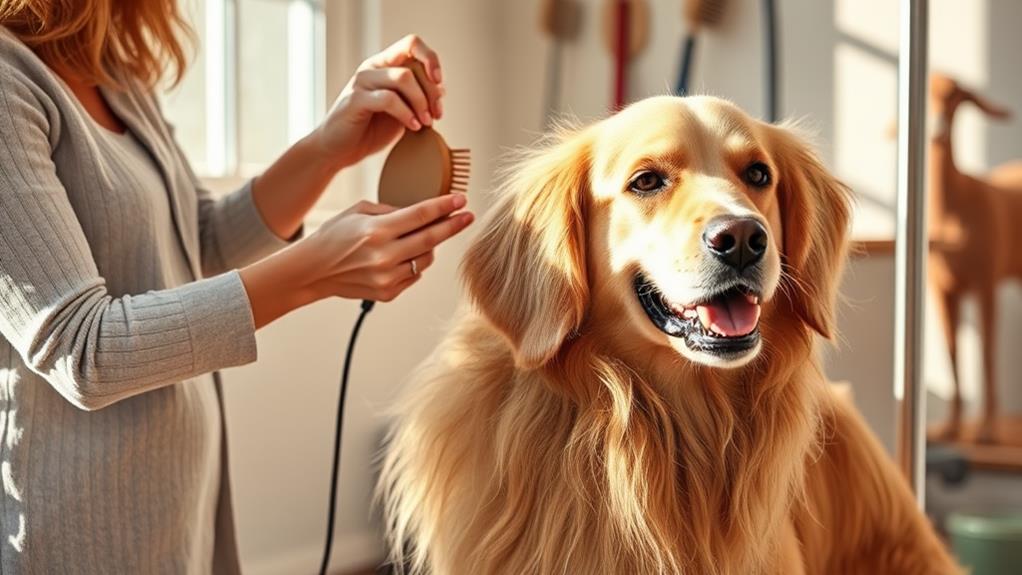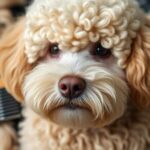When brushing your long-haired dog, choose the right tool like a slicker brush for tangles or a wide-toothed comb for gentle detangling. Set up a consistent brushing routine in a quiet spot to keep your pup calm and relaxed. Start at the base, working through sections with gentle strokes, and always use a detangling spray for tough knots. Check for mats regularly, and if needed, carefully snip them out. After brushing, inspect the coat, and consider applying a leave-in conditioner. There's more to mastering this grooming art that'll keep your dog looking fabulous!
Choosing the Right Brush

When it comes to grooming your long-haired dog, choosing the right brush is essential for maintaining a healthy coat. You'll want to look for a brush that suits your dog's specific coat type, whether it's straight, wavy, or curly.
A slicker brush is a great option for removing tangles and mats, while a wide-toothed comb helps detangle without pulling on the hair.
If your dog has a thick undercoat, consider using an undercoat rake to effectively remove loose hair. For those with sensitive skin, opt for a brush with soft bristles to prevent irritation.
Pay attention to the size of the brush, too. A larger brush is better for bigger breeds, while a smaller brush is more effective for smaller dogs. Don't forget to check the quality of the brush; investing in a durable, well-made tool can make a world of difference in your grooming routine.
Establishing a Brushing Routine

Establishing a consistent brushing routine is key to keeping your long-haired dog's coat healthy and free of mats. Start by setting aside a specific time each week dedicated to brushing. Whether it's every Sunday afternoon or a few minutes each day, consistency helps your dog become accustomed to the process.
Choose a quiet space where both you and your dog can be comfortable. This will help reduce distractions and make the experience more enjoyable for both of you. If your dog seems anxious, try to associate brushing with positive experiences—offer treats or praise to create a pleasant atmosphere.
Consider your dog's coat type and length when determining the frequency of brushing. Some long-haired breeds may require daily attention, while others might be fine with a few sessions each week. Pay attention to any mats or tangles, as they'll need extra care and might require more frequent brushing.
Lastly, keep an eye on your dog's overall coat health. If you notice any changes, like increased shedding or skin irritations, adjust your routine accordingly. Regular grooming not only keeps your dog looking good but also strengthens your bond.
Techniques for Effective Brushing

Effective brushing techniques can make a significant difference in maintaining your long-haired dog's coat. Start by selecting the right brush for your dog's coat type. A slicker brush works well for removing loose hair, while a wide-toothed comb is perfect for detangling.
Begin brushing at the base of the coat, near the skin, and work your way outwards. This method helps lift loose fur and debris while minimizing discomfort for your dog. Use gentle, even strokes, and avoid pulling on tangles. If you encounter stubborn knots, don't force it—take your time and work through them gently.
Brush in sections to guarantee you cover the entire coat. Divide your dog's fur into manageable parts, securing each section with a clip if needed. This technique allows you to focus on one area at a time, confirming thorough grooming.
Always praise your dog during the process to create a positive experience. If your dog seems anxious or restless, take breaks to keep them calm. Regular brushing not only helps keep their coat healthy but also strengthens your bond with your furry friend.
Dealing With Mats and Tangles

Your long-haired dog's beautiful coat can quickly become tangled and matted if not properly maintained. To handle mats and tangles effectively, start by using a detangling spray or conditioner. This can help loosen the knots and make the brushing process smoother.
Begin by gently separating the affected area with your fingers. Avoid pulling too hard, as this can cause pain and discomfort. Once you've separated the mats, use a wide-toothed comb or a dematting tool to work through the tangles. Start at the outer edges and gradually move toward the skin, taking small sections at a time. This method minimizes breakage and helps preserve the integrity of your dog's coat.
If you encounter a particularly stubborn mat, don't hesitate to cut it out, but only if necessary. Always opt for blunt-tipped scissors to avoid injuring your dog. After dealing with the mats and tangles, give your dog a thorough brush to guarantee the coat is smooth and free of any remaining knots. Regular maintenance will help prevent future mats and tangles, keeping your furry friend looking their best.
Brushing Different Coat Types

After tackling those pesky mats and tangles, it's time to ponder how to brush different coat types effectively. Each long-haired breed has a unique coat that requires specific techniques to keep it looking its best. Understanding these differences will help you maintain your dog's coat in top condition.
For breeds like the Maltese or Yorkshire Terrier, use a pin brush to glide through their hair gently. This helps to distribute natural oils and keeps the coat shiny.
Breeds like the Cocker Spaniel have wavy hair that can trap dirt and debris. Use a slicker brush to remove tangles and fluff up the waves for a beautiful finish.
Poodles and similar breeds need a comb to separate curls and prevent matting. Be patient, as curls can be tricky!
For breeds like the Collie, use an undercoat rake to reach through the top layer and remove loose fur from the undercoat. This prevents excessive shedding and keeps their coat healthy.
Grooming Tools and Supplies

When it comes to grooming long-haired dog breeds, having the right tools and supplies can make all the difference. Start with a good quality slicker brush; it's perfect for removing mats and tangles. You'll also want a wide-toothed comb to gently detangle any stubborn knots without pulling on your dog's fur.
Invest in a pair of grooming scissors or a thinning shear for those tricky spots around the ears and paws. These tools can help you achieve a neat appearance without compromising the overall coat length.
Don't forget about a good shampoo and conditioner specifically designed for long-haired breeds. They can help maintain hydration and keep the coat shiny. Additionally, a grooming table can make the process easier, providing a stable surface for brushing.
Lastly, a high-quality detangling spray can help manage any tangles between grooming sessions. Keep all your tools organized in a caddy or bag, so you're ready to groom whenever needed. With these essential grooming tools and supplies, you'll make the grooming process smoother and more enjoyable for both you and your long-haired companion.
Post-Brushing Care Tips

Once brushing is complete, it's important to focus on post-brushing care to keep your dog's coat healthy and shiny. This stage is essential for maintaining your dog's overall grooming routine and guaranteeing their comfort.
Inspect the coat: Check for any tangles or mats you might've missed during brushing. Address these immediately to prevent discomfort.
Bathe if necessary: If your dog's coat feels dirty or has a smell, consider giving them a bath. Use a gentle dog shampoo suited for long-haired breeds to keep their coat clean without stripping natural oils.
Apply conditioner: Using a leave-in conditioner can help to further detangle and soften the coat, making future brushing sessions easier and more pleasant for your dog.
Dry properly: If you bathed your dog, ensure they're dried thoroughly with a towel and, if needed, a blow dryer on a low setting. This helps avoid moisture buildup, which can lead to skin issues.
Frequently Asked Questions
How Often Should I Brush My Long-Haired Dog?
You should brush your long-haired dog at least three times a week. Regular brushing prevents matting, reduces shedding, and keeps their coat healthy. If they're prone to tangles, daily brushing's a good idea too!
What Are the Signs My Dog Needs a Professional Groomer?
Is your dog's coat looking unkempt? If you notice excessive matting, tangles, or a strong odor, it's time to call a professional groomer. Regular grooming helps maintain their health and guarantees a happy pup.
Can I Use Human Hair Brushes on My Dog?
You shouldn't use human hair brushes on your dog. Their fur is different, and those brushes might not effectively remove tangles or loose hair. Instead, choose brushes specifically designed for your dog's coat type for better results.
Are There Specific Brushes for Different Long-Haired Breeds?
Just like each flower needs its own sunlight, different long-haired breeds require specific brushes. You'll find slicker brushes great for tangles, while pin brushes work wonders for maintaining a healthy coat. Choose wisely for best results!
How Can I Make Brushing a Positive Experience for My Dog?
To make brushing a positive experience for your dog, start with short sessions, use treats, and speak soothingly. Gradually increase the duration, ensuring your dog associates brushing with pleasure and comfort rather than stress.
Conclusion
In summary, brushing your long-haired dog doesn't just keep their coat looking fabulous; it also strengthens your bond with them. Some believe that regular grooming helps reduce shedding and skin issues, and there's truth to that! By sticking to a routine and using the right techniques, you'll not only prevent mats but also promote a healthy, shiny coat. So grab your brush and enjoy those special moments—you might just find that grooming becomes a favorite part of your day!



